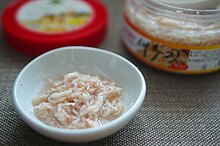Saeujeot
| Saeujeot | |

Saeujeot seasoned with chili pepper
|
|
| Korean name | |
|---|---|
| Hangul | 새우젓 |
| Hanja | n/a |
| Revised Romanization | sae(-)ujeot |
| McCune–Reischauer | saeuchŏt |
Saeujeot (Korean pronunciation: [sʰɛ.udʑʌt]) is a variety of jeotgal, salted and fermented food made with small shrimp in Korean cuisine. It is the most consumed jeotgal along with myeolchijeot (멸치젓, salted anchovy jeot) in South Korea. The name consists of the two Korean words, saeu (새우 shrimp) and jeot. Saeujeot is widely used throughout Korean cuisine but is mostly used as an ingredient in kimchi and dipping pastes. The shrimp used for making saeujeot are called jeotsaeu (젓새우) and are smaller and have thinner shells than ordinary shrimp.
The quality of saeujeot largely depends on the freshness of the shrimp. In warm weather, fishermen may immediately add salt for preliminary preservation.
The types of saeujeot depend on the kind of shrimp used and when they are harvested.
Putjeot (풋젓) is made with shrimp harvested from the end of January in lunar calendar through April. It is called deddeugi jeot (데뜨기젓) or dotddegi jeot (돗떼기젓) in the west coast of the South Korea. Ojeot (오젓) is made with shrimp harvested in May.
Yukjeot (육젓, 六젓) is made with shrimp harvested in June and is regarded as the highest quality jeot. It is the saeujeot most preferred for making kimchi because of its richer flavor and bigger shrimp than other saeujeot. The shrimp in Yukjoet have red heads and tails. Chajeot (차젓) is made with shrimp harvested in July.
Gonjaeng-ijeot (곤쟁이젓) or jahajeot (자하젓, 紫蝦젓) is made with very small shrimp-like Neomysis awatschensis, one of the opossum shrimp family which is called gonjaeng-i or jaha (자하, 紫蝦) in Korean. The shrimp used for it is the smallest among all saeujeot. They are harvested in August and September in small amounts where freshwater mixes with seawater of the abyss of the Yellow Sea. As it ferments, the jeot changes from transparent to light violet or brown in color and becomes soft in texture. Gonjaeng-ijeot is called gogaemijeot (고개미젓) in Jeolla Province. It is a local specialty of Seosan-gun, Chungcheong Province.
...
Wikipedia
